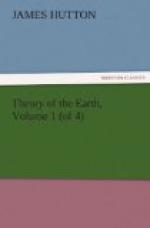But if we thus succeed to illustrate the theory of the earth by the natural history of those particular strata, we have but one step farther to make in order to bring all the other parts of the earth, whether stratified or not, into the most perfect consistence with the theory; now this step, it will be most easy to make; and I shall now mention it, that so the reader may keep it in his view: Pyrites is a sulphureo-metallic substance, which cannot be produced by means of water, a substance which the influences of the atmosphere decomposes or separates into its elements, and which even our imperfect art may be considered as able to produce, by means of fusion in our fires. Therefore, the finding of this creature of fire intimately connected with those consolidated strata of mineral coal, adds the greatest confirmation, were it necessary, to the doctrine of those mineral bodies having been consolidated by fusion. This confirmation, however, is not necessary, and it is not the only thing which I am at present to illustrate in that doctrine. What I have now in view is, to homologate the origin of those coal strata, with the production of every other mineral substance, by heat or fusion; and this is what the intimate connection of pyrites with those strata will certainly accomplish. This will be done in the following manner:
Pyrites is not only found in great masses along with the coal strata; it is contained in the veins which traverse those strata, and in the minute ramifications of those veins, which are occasioned by the contraction of the mass, and generally divide it into small cubical pieces; but besides that extrinsic connection, (as it may be called,) with the stratum of coal, pyrites is found intimately connected with that solid body, in being mixed with its substance. If, therefore, it were proved, that either the one or other of those two substances had been consolidated by fusion, the other must be acknowledged as having had the same origin; but now I am to prove, from the natural history of mineral coal, that pyrites had been there formed by fusion; and then, by means of the known origin of that sulphureo-metallic substance, we shall extend our knowledge to the origin of every other mineral body.
The process of this argument is as follows: Every mineral body, I believe, without exception, will be found so intimately connected with pyrites, that these two things must be concluded as having been together in a fluid state, and that, whatever may have been the cause of fluidity in the one, this must have also caused the fluidity in the other; consequently, whatever shall be proved with regard to the mineral operations of pyrites, must be considered as proved of every other mineral substance. But, from the connection of pyrites with mineral coal, it is to be proved that the origin of this metallic body had been fusion; and then it will appear, that all other mineral bodies must have been more or less in fusion, or that they must have been consolidated by means of heat, and not by any manner of solution or aqueous infiltration. I therefore now proceed to take a view of the natural history of coal strata,—a subject which mineralogists seem not inclined to engage with, although the most ample data are to be found for that investigation.




